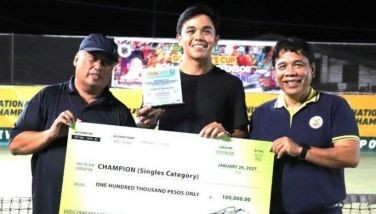Don’t panic: Only the poor have no rice

There’s no denying it, cheap government rice is gone. In public markets no rice is being sold anymore at the subsidized P27 per kilo. Accredited stalls of the National Food Authority are closed. Their stocks thinned out as early as January. No replenishments came. In February the NFA admitted it had only five days’ supply left in its warehouses. Five weeks have since passed.
Malacañang officials who say “Don’t panic, there’s enough commercial rice” are obfuscating. Sure, fancy varieties are aplenty; not only the grain harvest but also smuggling was bountiful last October-December. But those sell for P40-P60 a kilo, for the can-afford.
Cruelly the officials even bandy that “NFA rice make up only five percent of the country’s supply anyway, so no problem.” Fact is the poorest eight percent of Filipinos subsist on cheap NFA stocks. That’s precisely the point of the P27-price subsidy. To belittle that supply is like saying, don’t panic, only the poor have no rice.
The issue is why the NFA ran out of rice.
The agency’s duty is to always have cheap stocks on sale for the poor. On top of that it should always have a 15-day national emergency buffer. That buffer should even be for 30 days every lean season, July-September.
There are two ways of doing that. One, during harvests the NFA must buy palay (un-milled rice) from farmers. At a floor price of P17.50 a kilo, it protects farmers against bulk traders who procure for much less. Palay milling is on exchange-deal: the miller is paid in kind with by-products of darak (bran) and ipa (husk), in demand as hog feed and fuel. Still the NFA loses a fifth of the weight in the milling. And more as it passes on the milled stock at a discount, for accredited vendors profitably to retail strictly at P27 a kilo to verified penurious folk.
The second way is to import milled rice, usually in bulks of 250,000 tons per year from Vietnam and Thailand. Importing is cumbersome for the NFA, though lucrative for crooked officials who take multimillion-dollar kickbacks from suppliers. Imported stocks can cost up to P32 per kilo, including bagging, shipping, and cargo handling. Retailing at the subsidized rate of P27, NFA has lost about P250 billion over the years.
On record, the NFA’s 2017 imports arrived last October-December. On record too, the NFA did not buy palay at P17.50 a kilo during the wet season harvest, also last October-December, because traders supposedly were buying higher anyway. On record lastly, the NFA sold “aging” inventories last July-September, to give way in warehouses to the arriving imports.
Questions arose in last month’s Senate inquiry on the NFA rice depletion:
• Why did not the NFA buy palay last harvest time? Agriculture officials said farm-gate stocks were selling at only P13.50 a kilo in Bicol, Mindoro, and Palawan. Had the NFA intervened, not only would farmers have earned more, but it also would have shored up its buffers.
The NFA claimed there was no such cheap palay, as certified by farmers’ cooperatives. Whatever cheap palay it indeed had rejected supposedly were from flooded fields, quick to rot because containing more than 40 percent moisture.
• Why did not the newly arrived 2017 imports in October-December last till January-March 2018? Fewer calamities struck in 2017 to require distribution of NFA rice to victims. Only two strong typhoons in Eastern Visayas and Southern Mindanao, Mayon Volcano’s subdued eruptions in Bicol, and the Marawi terrorist siege, mostly before the arrival of the 2017 imports. Meaning, 2016 leftover inventories were used to tide over the victims in those regions. The fresh 250,000 tons in late 2017 should have been sufficient till the first four months of 2018. So said the NFA’s inter-agency governing Council, based on past years’ experience.
NFA management countered that it’s all the Council’s fault. The latter allegedly kept disallowing it from importing another 250,000 tons for 2018. That didn’t answer the question of sudden depletion of the 2017 imports. But it revealed that the NFA management and Council are still at odds over facts and policies.
• What “aging” stocks did NFA sell during the lean season, July-September, and beyond? Quoting insiders, senators said the central office ordered regional staff to sell their 2016 inventories to three traders in Bulacan. Even the first arrivals of 2017 imports were included. Purportedly the stocks first were mislabeled as expired, even if still edible. The favored traders bought them dirt cheap for resale at commercial rates. Certain central officials earned tens of millions of pesos in kickback of P100 per sack. Market vendors swore that the “commercial” stocks distributed to them by the traders came in NFA sacks. Thus did the whole 2017 imports quickly run out.
The NFA management claimed that what it sold were 700,000 sacks of very old 2014-2015 stocks. Supposedly they just implemented the usual policy of bidding out inventories more than six months old.
Past NFA administrators cried foul. Allegedly they already had disposed of the 2014-2015 old stocks before they stepped down in June 2016.
To determine who’s telling the truth, the NFA Council has ordered an independent audit. Documents and figures will show if domestic palay indeed was way beyond the NFA’s buying price last harvest, how long the 250,000-ton yearly imports should last, and what “aging” stocks were sold last lean season.
* * *
Catch Sapol radio show, Saturdays, 8-10 a.m., DWIZ, (882-AM).
Gotcha archives on Facebook: https://www.facebook.com/pages/Jarius-Bondoc/1376602159218459 , or The STAR website http://www.philstar.com/author/Jarius%20Bondoc/GOTCHA
- Latest
- Trending



























